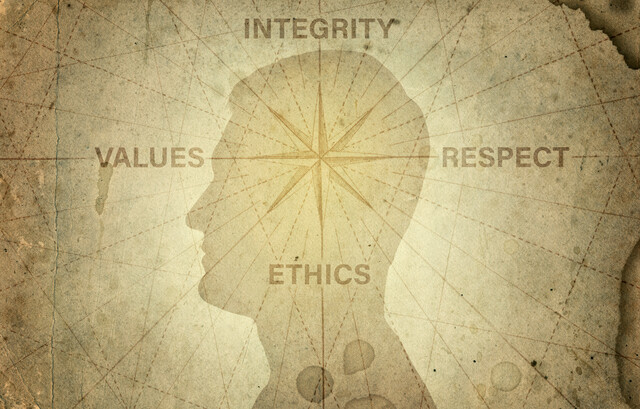Basics of Body Language
Have you ever been in a situation where you wished you knew what another person was thinking? You're sitting at a restaurant on a blind date. Sitting across from you is an attractive, well groomed, and financially secure man. You smile at him and ask questions and he responds with short answers, or he nods his head in agreement. You eat your dinner and sip your wine with polite smiles back and forth. Suddenly, you wonder if he is just the quiet type, or if you are more interested in him than he is in you. It would be very helpful to you if you knew what was going on inside his head, but you know that's not possible. So, you continue your date waiting patiently for some clue as to how he feels. Inevitably, you will know soon enough. It's the waiting that drives you crazy. At the end of dinner he drives you home, thanks you for a lovely time and says he'll call you. You think to yourself, "That's it?" You are no closer to knowing how he feels than you were at the beginning of your date.
The next morning as you are driving to work your cell phone rings. You pick it up to hear Mr. Blind Date from the night before. He tells you that he didn't really feel a connection with you and wants to continue his quest for the perfect woman. Your mind swims in wonderment as to what could have happened to make him feel this way. You wore your perfect red dress and shoes. Your hair was done perfectly and your perfume was light and not overpowering. He had complimented you on your appearance. You were polite, didn't chew with your mouth open or send your food back to be cooked longer (something you personally loath in others).
You decide to chalk it up to bad luck and swear an oath to never date again. It's probably an oath you will break, considering it was your first date in over six months and you truly liked the experience. You still can't get this out of your head and think to yourself, "If I could have known what he was thinking, things might have turned out differently." Maybe he was bored with the restaurant and wanted to go someplace more exciting. If you had known this, you might have said, "Let's get out of here and go dancing or to the movies."
Well, look no further. It's all about reading body language, and it is your key in this situation. By watching another person's hand gestures, posture, facial expressions, hand movements and other subtle things, you can actually tell what they are thinking. More often than not, we tend to take body language for granted. There are people who specialize in this particular field, but the average person, like yourself, doesn't really pay too much attention to the subject.
Allow me to enlighten you; it can be helpful in a vast number of situations, even life-saving. It's as simple as an eyebrow movement, a lip curl, or a nose wrinkle. They can all mean very distinct things if you know what to look for. By knowing ahead of time what's going through another's mind, you can control a situation before it becomes out of control. It can allow the doors of possibility to open for you.
When you talk to someone by waving your hand, nodding your head, or even crossing your arms, you are communicating. Body language is the phrase we use for these movements and gestures. This also incorporates the most subtle of movements that people may not be aware of, including winking, the slight movement of the eyebrows, and other facial expressions.
Paralanguage is defined as nonverbal communication. Body language is a part of paralanguage and it has been studied in the psychology field by many experts, in particular, the involuntary body language like smiling and frowning.
People send and receive nonverbal messages and signals all the time without even knowing it. In the grocery store, you may see a woman pick up a green pepper and frown. She's not aware that the signal she's sending out is one of disapproval. Some people see it and some people don't. These signals may indicate what a person is truly feeling. The technique of "reading" people is used quite often. For example, we teach our children from an early age to look people in the eye when speaking. Children tend to look up and down, everywhere except into the other person's eyes.
Maintaining eye contact is an indicator that the person is positively thinking about what is being said to them. In other situations, it can mean that the person doesn't want to take his eyes off the other, which can mean a sign of distrust. A person who makes direct eye contact, but plays with the chipped paint on the table at the same time, or plays with his hands, may not be really paying attention to you; he's distracted and his attention is elsewhere. There are also those individuals who have been diagnosed with an attention deficit disorder and cannot continuously maintain eye contact; they are simply unable to do this. So, you don't want to make a hasty judgment without considering all of the factors to the situation.
The most basic and dominant form of body language occurs when a person crosses their arms. This particular gesture can be interpreted in many different ways. Sometimes it can mean they are putting up a wall between themselves and others, sort of like protection. It can also indicate they are cold, and are crossing their arms for warmth. Maybe you are in a business meeting and the man across from you crosses his arms. This doesn't always mean he's trying to put a barrier between himself and the speaker; rather, it could mean he's listening intently and taking in all of the information. On the other hand, it could be looked upon as a warning signal that the person is very upset. If he is leaning back in his chair and has a frowning or callous expression on his face, this may be a good indicator of hostility. Such a person is not an ally, and may have controversial motives.
Disbelief can be indicated by a gaze that wavers around a speaker's head instead of looking them directly in the eye. When someone rubs their chin or touches their ear, this can also mean they don't believe what is being said. When a person is not being convinced by what someone is saying, their attention invariably wanders, and the eyes will stare away for an extended period.
You will know right away that you've encountered a bored person, as they will be looking at anything but the speaker. They are likely to tap the table with their fingers or tap their feet. Sometimes they do this repeatedly. You will most likely see them looking around the room from the speaker to the clock on the wall and back again. They might fidget in their seat, play with their hands, or tilt their neck.
There are also cultural differences in people that could lead to a misunderstanding of body language, so be careful about your analysis and consider all of the factors first.
There are many people who are fascinated by the idea of being able to read someone's body language once the concept is introduced to them. One of the things that may surprise people is that body language, or nonverbal communication, makes up more of what we usually say than does verbal language.
Being able to understand and read body language is a very useful tool. You will be pleasantly surprised to learn that you can use the art of reading body language to:
-- understand what someone means, even when they aren't saying it
-- use it to your advantage for employment and interviews
-- avoid aggressive situations that can become more heated
-- learn what factors can affect body language, such as alcohol
-- put your best foot forward for presentations and meetings
-- discover patterns in someone's body language
-- use self reflection to avoid negative behavior to be seen by others
Those are just a few things that one can learn from understanding how to read body language. At first it may seem complex, but once you learn some of the common things that people do in varying situations, it will become easier to detect and respond to someone's body language.
Body language is a non-verbal way of speaking. It is an unspoken language that often says more than what is being said verbally. It is a form of body communication that looks at what is being said beyond the verbal language. Body language is a subcategory of paralanguage, which is the area of human communication that is nonverbal. It can include such things as raising the eyebrow, winking, or a number of other facial expressions.
When considering body language it's important to keep in mind that some of it can be voluntary, while some is involuntary. Voluntary body language would include things like the way someone stands, folds their arms, or smiles. Involuntary body language is a little more complex, as it includes such things as blood rushing to the face when someone is embarrassed. This involuntary form of body language often covers facial expressions that someone does not deliberately make.
In many cases, body language is "spoken" unconsciously. We learn to use our body language from a very early age. Little girls will smile and tilt their heads when they want adoration or attention, and little boys will cross their arms in front of them and frown when they don't get the toy they want from the store. The quality of our communication is an extension of our body language. Sometimes using body language instead of our voice gets the message across more clearly. You may be tired of constantly telling little Jimmy to clean his room, so this time you look directly at him with your arms crossed and tap your foot, until he understands you are serious. This would be a form of conscious body language and it may just get the job done.
Body language is displayed by using the different parts of your body, including your eyes, arms, hands, feet, posture, head position, facial expression, etc. When dealing with others, the way you use your body language can have a significant impact on how things are perceived. Eye contact is crucial in dealing with others. You want to maintain good eye contact, because it is seen as a sign of respect. It also shows that you are interested in the speaker. This doesn't mean fiercely focused eye contact, just casual contact. If you look like your eyes are boring into the person to whom you are speaking, it is likely that you will make them feel uncomfortable. You can casually look away from time to time, but make sure at least 75 percent of the time you are making eye contact.
Movements of the arms are an indicator of how open or closed a person is. When meeting new people or making contact with business associates, you want to avoid crossing your arms in front of you. This is a sign of defensiveness or being closed to the other person. Try to keep your arms out to the side of your body, or clasp your hands together behind you in a casual manner. This position shows openness and optimism. People who are really open tend to use their arms a lot in big movements. Of course, on the other hand, people who are not as open don't use a lot of hand and arm movements. So, in different situations you will want to send different messages by using your body language.
Posture is also very important. When we see someone slumped in a chair, we automatically think they are sad about something, or they don't have very high self esteem. Good posture portrays positive feelings about yourself and others. Whether you are sitting or standing, try to maintain good posture; a person who has good posture and keeps their head held high will send a more positive message than someone who is slouched and/or looks downcast.
Shaking hands is something we all have to do from time to time. If you attend business meetings on a regular basis you may have to shake hands more than the average person. You should always offer your hand palm out vertically, not up or down. This creates the feeling of equality. Palm up would signify submission and palm down would signify domination.
When conversing with someone, the position of your head comes into play. If your head is straight forward, not slightly tilted or slightly down or up, it is perceived that you are confident and self assured. Going back to the earlier example in which little Jimmy was asked to clean his room, it is best to use the straight on head position, which also demonstrates authority. When you are in a friendly situation, like out with friends, you can use the slightly tilted head, which represents your receptiveness.
When it comes to the distance between you and another person, cultures vastly differ. Typically, when you stand too close to another person and you are face to face, they tend to either turn away from you or back up. Some will perceive you as being a pushy or domineering person. However, if you stand too far away, the effect is opposite and you are perceived as a shy or distant person. You should maintain a distance that is not nose to nose, and not at the other end of the table from the other person. As you communicate, you will be able to determine what is too close, and what is too far, by watching their body language.
Our body angles are probably the easiest to read. We tend to angle our body away from people we do not find interesting, and angle our bodies toward people we like, or find attractive. Take, for example, a housewarming party. You are sitting at a table right next to someone you don't know and a conversation starts (by you or the other person). As you are conversing, you realize you have common interests. You start talking about the common interest and you notice that the other person rotates his chair so that he is facing more toward you rather than sitting shoulder-to-shoulder. There are times when this will be out of our control. For example, at amusement parks when it's crowded and you are almost shoulder-to-shoulder with everyone around you, or when you are sitting inside an attraction in theater seats that face forward.
When you are sitting down, your legs can give certain indications of how you feel at the moment, or what type of person you are. When standing in line, if you are an impatient person your legs will move around more than a patient person's legs. And, if you are sitting impatiently, you might tap your feet or shake your legs. It's not always easy to see a person's legs if they are sitting down, so it's a hard body language to follow. As far as crossing the legs, comfort comes into play first, and foremost, so it's not as easy to read.
Facial expressions are also easy to read. It is also easy for us to use facial body language involuntarily. We frown when we are not happy with something, and smile when we are. Tight lips can mean that you are holding yourself back from saying something that might be offensive to another person. Imagine what your face looks like when you reach into your refrigerator, pull out the milk and it smells as if it is spoiled. That is definitely an involuntary use of body language that will let everyone know exactly what you are thinking.
Another area of nonverbal communication, personal space, is largely influenced by one's culture. This form of communication is important to observe, especially if you are an American that is talking to someone of another culture. Americans tend to like more personal space than many other cultures. Americans tend to prefer standing two to four feet away from someone during a conversation, especially if it's someone they don't know well. As such, Americans tend to pull back if someone has moved into their personal space to the extent that it has made them feel uncomfortable. The body language of moving back, especially if done so abruptly or with facial gestures, can send nonverbal messages to the person who has moved into your space. It's important to keep in mind that nonverbal communication, especially something like issues with personal space, are greatly influenced and interpreted by culture.
























